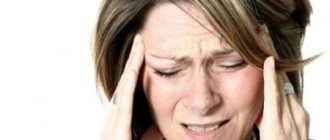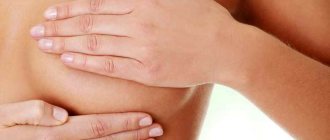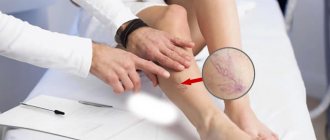Why does pain occur?
People who lead a sedentary lifestyle and have a weak muscular frame are predisposed to this kind of disease.
The cause may be either disproportionate physical stress on the neck (lifting significant weights, carrying them on the shoulders), or prolonged stay in one position with an elongated and tense neck, as well as hypothermia, prolonged exposure to a draft. Various injuries to the ligamentous apparatus of the neck, as a rule, make themselves felt immediately with acute pain, but sometimes symptoms appear several hours after the injury. In people susceptible to anxiety disorders, a spasm of the neck muscles is possible due to nervousness; treatment should include not only medications, therapeutic exercises and physical therapy, but also taking sedatives and consulting a psychologist. A person who is in a constant state of anxiety and stress is tense, unconsciously holding his whole body in tension, including his neck, as if trying to protect himself from an external threat, and cannot allow himself free movements.
Symptomatic picture
The intensity and localization of pain depends on the cause. People with weak ligaments often complain of regular pain, usually dull, aching, localized in a small area of the neck, which occurs in the morning, after sleeping on an uncomfortable pillow, and after prolonged work in one position. Often, the unpleasant sensations go away on their own during the day, but they can also intensify. Characterized by headache, dizziness, numbness of the shoulder girdle, back of the head, tingling sensation, goosebumps. Sudden changes in blood pressure are possible: there may be a sudden decrease in pressure, manifested by unexplained drowsiness, weakness, darkening of the eyes, or a significant increase.
If a ligament is sprained or torn, most often acute pain, muscle spasm and swelling immediately occur, but there are rare cases where the first symptoms appear only several hours after the injury.
With osteochondrosis, the pain intensifies with movement and is practically not felt at rest; it can radiate to the ear, back of the head, lower jaw, and less often to the suprascapular region.
In the presence of intervertebral disc herniation, pain occurs suddenly after some kind of physical activity or even after a careless, too sudden movement, it is highly intense, and intensifies not only with movement, but even with coughing or sneezing. May radiate to the arm or shoulder. The patient is forced to keep his head tilted in the direction opposite to the location of the pain.
With infectious myopathies, pain usually occurs on the right or left and affects not only the neck, but also the shoulder, arm, even fingertips, and swelling of the hand may be observed.
Myofascial syndrome of the trapezius muscle is characterized by acute pain between the shoulder blades.
Diagnostic measures
Since muscle spasm can be a manifestation of such serious diseases as myositis, spinal hernia, ruptures and sprains of ligaments, bone tumors, and also have serious consequences in the form of blood pressure disorders, oxygen starvation of the brain, compression of the nerve roots of the spine, it is necessary to undergo an examination to find out the exact causes of neck muscle spasm. A neurologist treats myalgia.
The diagnosis is made based on a set of signs. The doctor should clarify the duration of pain and its location, find out the presence of additional symptoms, conduct a palpation examination of the neck, and check trigger points. In this case, the following is determined: the degree of limitation in movements, pain points, the extent of the lesion, local muscle tone. After a general examination, additional studies may be necessary: an x-ray of the cervical spine (prescribed in almost all cases, it allows you to identify disorders of the spinal column: osteochondrosis, cervical spondylosis, fractures, tumors, and also clarify the extent of motor dysfunction.
If there is a suspicion of an intervertebral hernia, muscle mass or spinal cord lesion, an MRI of the cervical spine is prescribed.
Diagnostics
Methods for eliminating and treating spasms depend entirely on what exactly caused the disorder. The doctor refers the victim to:
- MRI of the neck and head, which allows you to evaluate the structures and cells of the brain and identify diseases at the earliest stages.
- X-ray of the spinal column.
- Computed tomography of the cervical spine.
- Ultrasound with duplex scanning to find out if there are changes in the artery wall and determine the speed of blood flow.
- Angiography. To accurately diagnose the condition of blood vessels, contrast angiography is used in patients to determine the diameter of the lumen even in the smallest arteries and veins.
Important! Vasospasm is not always considered a consequence of the loss of elasticity in the walls of blood vessels. In some cases, turning sharply and unsuccessfully is enough to cause pain. But even here the doctor will not be able to immediately make a diagnosis. The victim needs to undergo an ultrasound, MRI and other examinations so that the appropriate course of therapy can be determined.
How to overcome the disease
Drug therapy and physiotherapy are used, and massage is especially effective. If the cause is such serious diseases as infectious myopathies, hernias and fractures of the vertebral disc, therapy for the underlying disease is necessary.
Treatment of neck muscle spasms with drugs is recommended in the presence of intense pain. There are three main groups of drugs used for this pathology:
- NSAIDs (non-steroidal anti-inflammatory drugs) - have anti-inflammatory and analgesic effects. They can be prescribed not only in the form of tablets and injections, but also as part of ointments;
- Muscle relaxants are “first aid” for quickly relaxing muscles. They are usually used in the form of intramuscular injections and are indicated for severe symptoms of muscle spasm in the neck, the treatment of which with other methods does not bring results;
- Medicines to improve blood circulation (for blood pressure disorders);
- As an additional treatment, the doctor may prescribe B vitamins and chondroprotectors.
Physiotherapy is no less effective than the use of medications, since it not only treats spasm of neck vessels, but also affects their causes, has an analgesic and anti-inflammatory effect. Electrophoresis, magnetic therapy, reflexology, ultrasound, massage are used. For neck injuries, it is necessary to wear a Shants collar.
What causes vascular spasms?
Cerebral vasospasm (another name for cerebral vascular spasm) can occur for various reasons. This is caused by problems not only in the brain, but also in the cervical region, where the arteries supply blood to the brain cells.
Prolonged severe fatigue, lack of sleep, oxygen starvation, poor blood supply significantly affect the condition of blood vessels, as do some vascular diseases.
The most common causes of cerebral vascular spasms:
- chronic stress and fatigue;
- lack of sleep and oxygen;
- nicotine;
- degeneration of vascular walls due to age-related changes.
Diseases that provoke spasm of cerebral vessels:
- cervical osteochondrosis;
- hypertension;
- VSD;
- renal disorders;
- tumors.
Such serious factors are not the only culprits in the occurrence of spasm symptoms. A sharp constriction of blood vessels can occur, for example, when cooling the head without a hat, taking a large dose of alcohol, or a sudden surge of emotions (including positive ones). If earlier the disease was considered age-related, when the vessels lost elasticity and changed due to natural patterns, today the pathology has become significantly “younger”, becoming a frequent companion of residents of megacities, where the ecology, rhythm of life, and air pollution leave much to be desired.
At-risk groups
Spasm of cerebral vessels threatens certain categories of people whose body is least protected from the problem. Most often these are individuals with certain diseases or a sensitive vascular system:
- suffered a heart attack, stroke;
- diabetics;
- hypertensive patients;
- those suffering from angina pectoris;
- prone to thrombosis;
- mentally unstable;
- persons who react acutely to changes in atmospheric pressure.
help yourself
If physical stress causes muscle spasms in the neck, treatment with exercises and self-massage can be quite effective without the use of medications.
The massage should be carried out carefully, with light circular movements, avoiding sudden movements or strong pressure. Massage the neck, back of the head, shoulders and upper back. The use of various massage devices (for example, Kuznetsov’s applicator, Lyapko’s needle applicator) has worked well.
A warming cream will help reduce the intensity of pain - it is applied to the back and side of the neck. If you don’t have cream on hand, you can wrap a warm scarf around your neck.
Exercises to promote relaxation - head and shoulder rotations. Treatment of neck spasms with exercises is not recommended if the pain symptoms are significant - careless movement can increase the pain and even lead to injury to the swollen, tense muscle.
During the recovery period, doctors recommend taking a course of mechanotherapy, which is a set of exercises aimed at strengthening the muscle frame.
Treatment methods for cervical vasospasm
Only an experienced specialist can tell you how to treat the vessels of the neck and head, based on the examination results. Applicable:
- Drug therapy.
- Physiotherapy.
- Folk remedies.
While the spasm is being relieved, experts tell their patients to avoid therapeutic exercises while the disease is in the acute stage.
Drug treatment
- If the cause of the pain, which intensifies when coughing and turning the head, is hypothermia, the patient needs to limit physical activity, take a warm shower or bath, lie down, and if the pain does not go away, consult a specialist.
- Since acute spasm of the vessels of the head and neck can be quickly relieved with intravenous injections, patients are recommended to use No-shpa, Baralgin, Renalgan. Injections can be performed on an inpatient or outpatient basis, depending on the patient’s condition.
- Nootropics containing hopantenic acid improve metabolism in neurons. The most effective drug is Pantogam, whose action is aimed at restoring brain function.
- For hypertension, blood pressure medications are prescribed. The dosage and name of the drug are determined by the doctor.
- Spasm may be a symptom of nervous tension, so such patients are prescribed antidepressants.
Adaptogens relieve symptoms of all types of headaches and have a beneficial effect on the body. These herbal preparations strengthen protective functions and help a person withstand severe frosts and unbearable heat:
- One of the most popular adaptogens is ginseng. It is used in the complex treatment of pathologies of the spinal column, thrombosis, diabetes mellitus, and gastrointestinal diseases. The drug is used in the off-season, taking 2 tablespoons of the drug diluted with water on an empty stomach.
- Schisandra is considered a strong drug. It is recommended for depression and hypertension.
If a person has atherosclerosis of cerebral vessels, Papaverine, Drotaverine, Spazoverine can improve blood circulation and relieve spasms.
Physiotherapeutic treatment
To improve muscle condition, physiotherapeutic treatments are carried out, for example, post-isometric neck relaxation. This method does not apply to manual therapy. The procedure is based on stretching soft tissues and muscle relaxation, after which excess tone is removed and pain is eliminated.
Cryotherapy gives good results, but is not very popular due to the high cost of the procedure.
To relieve the symptoms of spasm of the neck artery, acupuncture is used. Manipulations are carried out only by an experienced specialist, otherwise the condition may worsen.
Folk remedies
There are many folk methods that save the victim from vascular spasm and unpleasant symptoms:
- A compress made from a cabbage leaf applied to the forehead is an excellent remedy for ailments.
- If the pain is pulsating and radiates to the temples, use garlic. They rub it on painful areas of the head. Melissa oil has the same effect.
- A decoction of St. John's wort improves the condition. It is drunk to strengthen blood vessels in the brain along with calendula decoction. The plant ingredients are mixed in equal proportions and poured with boiling water. Wait 15 minutes, filter and drink the infusion in a third of a glass.
- Spasms can be relieved with thyme tincture. A large spoonful of herbal raw materials is poured into a glass of boiling water, infused, filtered and drunk when cooled.
- An effective preventive remedy is rosehip decoction. It is recommended to drink it on an empty stomach, a glass a day.
Prevention
A well-developed muscular frame of the neck minimizes the likelihood of various injuries, so the basis of prevention is physical exercise and an active lifestyle.
If work requires constant being in one position, it is necessary to take fifteen-minute breaks for gymnastics every 1-1.5 hours.
Neck pain can be caused by an uncomfortable position while sleeping, so it is advisable to purchase an orthopedic pillow and spend ten minutes doing exercises in the morning.
A lack of important elements in the diet (calcium, magnesium, B vitamins) contributes to weakening and degeneration of muscle and bone tissue, which leads to osteochondrosis, so it is important to eat properly.
The most common cause of neck muscle spasms is overexertion, which occurs due to the fact that a person is in an uncomfortable position for a long time, experiences physical discomfort, but does not pay attention to it. Therefore, the most important thing in preventing any disease is to be attentive to your body and not ignore its signals.






